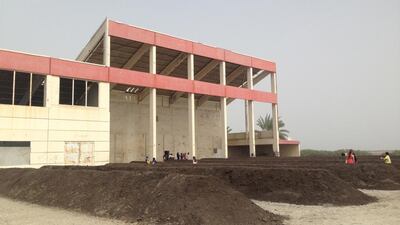I spent the second half of the weekend exploring the new venues for Sharjah Art Foundation (SAF), which were filled with art for the first time for Sharjah Biennial 12 (SB12).
On Saturday morning, I joined the group gathered at Sharjah Art Museum and jumped on one of many buses headed for two locations: The Flying Saucer Building and Kalba Ice Factory.
First stop was The Flying Saucer Building, originally built as a French bakery and then used as a fried chicken restaurant and then left empty. Now it has been snapped up by SAF who will be using it for future art projects.
For SB12, Egyptian artist Hassan Khan produced a number of pieces that transformed the building. Firstly he put neon coloured panels up on the glass, casting the whole interior in colour. He also made two interesting glass sculptures, whose transparency only reflected the colours around.
An 8-minute video work titled The Slapper and The Cap of Invisibility was also playing. This dark comedy sketch, reminiscent of a Samuel Beckett play, featured two men in a futile argument that seemed to question everything we consider to be reality. Outside and on top of this hexagonal shaped structure are two billboards made in collaboration with Andeel, an Egyptian cartoonist known for his wry humour.
After taking in this wonderful show, we got back on the buses and made our way across a rather dusty Emirates to the East Coast to the sleepy town of Kalba.
When we finally made it to the abandoned ice factory, it was clear why the team had fallen in love with the building – although we did wonder how on Earth they found it. With a striking angular structure and a partly red façade, the building has been the epicentre of a project by Argentinian Adrián Villar Rojas for the last two months. Outside, he and his team had laid a series of long piles, or reverse trenches of soil and pungent matter, which functioned as corridors to funnel in visitors.
But inside the building was where the real show took place, the artist had filled the whole space with columns and structures made from organic matter that the team found in the surrounding areas. Soil, parts of trees, roots, stones, shells, bones and even dead birds were used to make the structures, which were crawling with ants and each had their own distinct smell.
The colours, which I’m not sure if they came from local plants or natural dyes, made the entire scene come alive and the odd remnant of a human being – a shoelace, a child’s pullover or a pair of trainers, remind us of the unnatural materials we surround ourselves with.
The whole affect was quite overwhelming and knowing the artist's fascination with architecture, it makes me think that somehow the long journey from the towering skyscrapers of Dubai and Sharjah to the low laying fishing village of Kalba was part of the performance and here, in this strange building, we saw another city scape but this time made of found material. Titled Planetarium, perhaps he is commenting on the way we destroy our world and the possibility of bringing life back to it.
Although it is a long way to go and you feel in the middle of nowhere when you get there, it is definitely worth the journey.
* Sharjah Biennial 12 runs until June 5. For more info visit www.sharjahart.org

